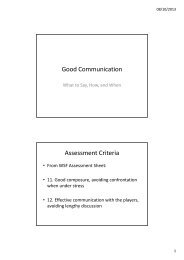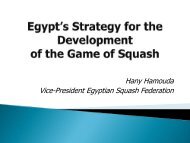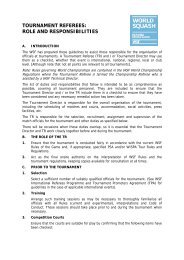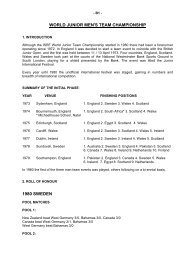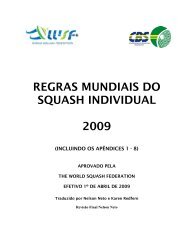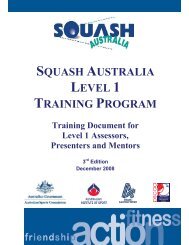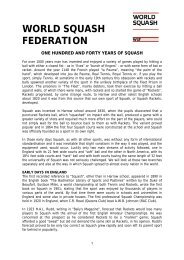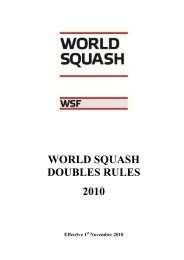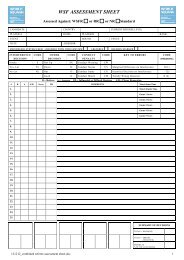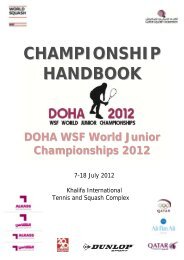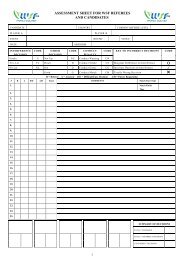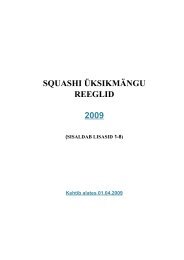A referee's phrasebook - World Squash Federation
A referee's phrasebook - World Squash Federation
A referee's phrasebook - World Squash Federation
Create successful ePaper yourself
Turn your PDF publications into a flip-book with our unique Google optimized e-Paper software.
A referee’s <strong>phrasebook</strong><br />
(created dby Ian Allanach)<br />
What to say and when<br />
The “accepted” explanations<br />
1
Why 1<br />
• Player is entitled to a brief explanation<br />
• Guideline G19 : “may be appropriate to<br />
explain the decision…..referee may give a<br />
concise explanation….”<br />
• Agreed phrases offer consistency to players<br />
• A timely response gives players confidence<br />
2
Why 2<br />
• Agreed phrases prevent awkward referee silences<br />
• Agreed phrases stop referees “making something<br />
up” in heat of moment<br />
• A timely response shows referee knowledge,<br />
understanding di and control<br />
• Agreed phrases show consistency among referees<br />
• Of particular help to those for whom English is not<br />
their first language<br />
g<br />
3
And in 3 referee system<br />
• The giving gof explanations by central referees can<br />
vary. Matches run more smoothly when you do.<br />
• Silence or “We are agreed” etc does not come<br />
across well<br />
However<br />
• This <strong>phrasebook</strong> actually help referees arrive at<br />
their decisions<br />
• The <strong>phrasebook</strong> then provides the short clear<br />
explanations<br />
4
Decisions and phrases<br />
• We will look at each of the interference<br />
decisions in turn<br />
• Possible explanations are listed<br />
• Advice : practice saying these in your head<br />
or at home. Not only to get phrase right but<br />
to get tone right. You will sound really<br />
confident (and correct)<br />
5
“No let” decisions 1– request<br />
made by striker<br />
• There was no interference<br />
• Interference was minimal (and did not prevent you<br />
getting to and playing the ball)<br />
• You made the interference or you played the man,<br />
not tthe ball or you were tki taking an indirect idi tline to<br />
the ball<br />
• You would not have reached that ball (players do<br />
not like this one)<br />
6
“No let” decisions 2 (cont)<br />
• You were not making every effort to reach the ball<br />
or you need to make more effort to play the ball<br />
• You accepted the interference or you went past the<br />
interference and could have played the ball<br />
• The ball was past you or you were not in a position<br />
to play the ball<br />
• It was a winning shot ( by your opponent)<br />
7
“Stroke” decisions – request by<br />
non-striker(unhappy at stroke)<br />
• He had no shot to the front wall<br />
• You made no effort to clear or you were<br />
unable to clear<br />
• You prevented your opponent’s swing/shot/<br />
winning shot or you were in his swing or<br />
you are crowding your opponent or you must<br />
give your opponent freedom of swing<br />
8
“Yes let” decisions – request<br />
from striker (looking for stroke)<br />
• You had room to play or your opponent was clear<br />
• Interference was some distance from ball<br />
• There was interference on your swing/shot – it was<br />
not prevented<br />
• You were still preparing your shot or you had not<br />
fully prepared<br />
• The ball was too tight or you could not have played<br />
a winning shot<br />
9
“Yes let” decisions – request<br />
from non-striker (unhappy at<br />
let)<br />
• There was interference(contact)<br />
• There was interference on your opponent’s<br />
swing<br />
• He would have reached the ball(but for the<br />
interference)<br />
• There was a fear of injury or it is a safety let<br />
10
Caution<br />
• Try not to personalise explanations or imply<br />
negatives in player’s game e.g.<br />
• “It was a poor shot”<br />
• “You were too slow”<br />
• “You are not that tall” (on a lob)<br />
• “You made the wrong choice of shot”<br />
11
Confirming calls<br />
• If questioned about an out, down, not up, etc.<br />
• Play a let if genuinely unsure<br />
• Use phrases such as “I saw the ball good,<br />
down, out”, etc. – better than ” It was out,<br />
down”, etc.<br />
• “I saw it good” – who can argue<br />
12
Player views<br />
• If both players agree a ball was up, down, etc.,<br />
accept it, thank them, and alter a call if necessary.<br />
• If, after giving an interference decision eg “stroke<br />
to …”, players say “we are happy with a let”, do<br />
not change the decision – better to say “Thank you,<br />
but as referee, I saw a stroke situation” ti – and dthen<br />
stick with your decision<br />
13
Communication with players<br />
• Acknowledge the points being made eg<br />
• Mr A – I saw the contact but it was minimal<br />
• Mr B – I hear what you are saying but it is a let<br />
• Mr C - I understand the point you are making - I<br />
am watching<br />
• This shows you are aware and helps player<br />
communication and confidence<br />
14
The perfect pitch<br />
• A combination of tone, confidence, courtesy, eye<br />
contact, smile, nod of head – that says “that’s the<br />
decision and trust me, it is correct”<br />
• Easier to adopt when eye contact possible – hard on<br />
microphone<br />
• But – don’t say it too fast or too short – you know<br />
the phrase – players on court may struggle to hear<br />
eg “There was room to play” rather than “Room to<br />
play”<br />
15
Follow up<br />
• Have the <strong>phrasebook</strong> in print<br />
• Practise<br />
• Remember the tone – factual and confident<br />
• Do not get drawn into debate – repeat phrase eg<br />
“Why a let” - “There was room to play” – “Sure”<br />
– “Yes” – “Room” – “Yes – there was room”.<br />
(better to repeat than an immediate”Play on<br />
please”).<br />
16
And now<br />
• Comments<br />
• Questions<br />
17



